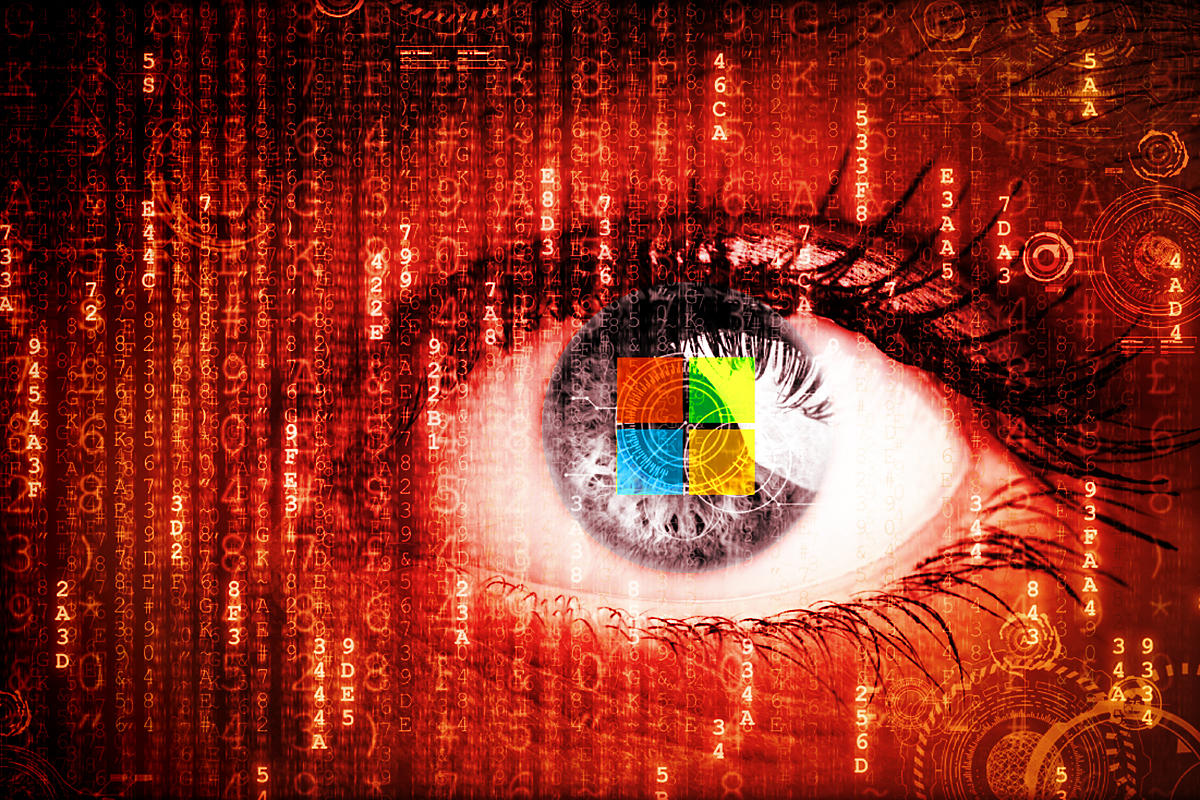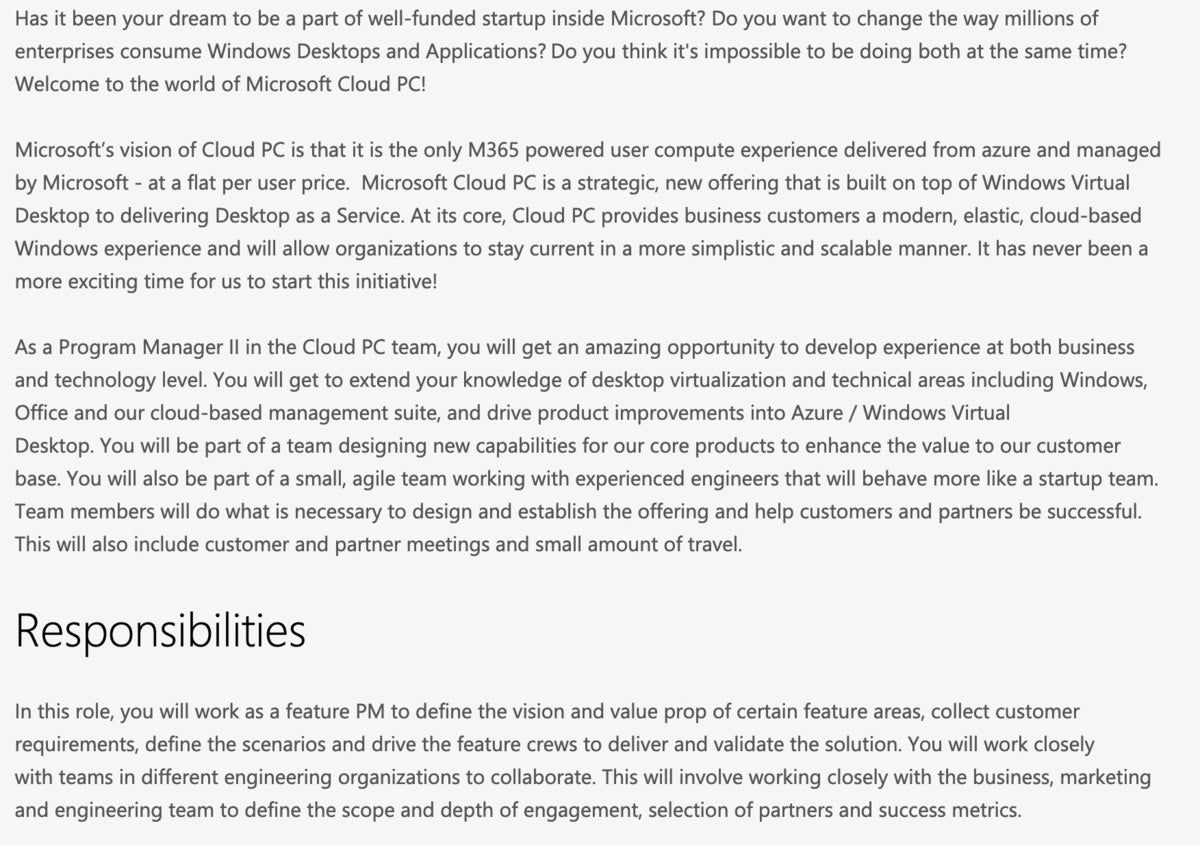A recent job posting by Microsoft indicates the company may be crafting a new device-as-a-service subscription offer for Microsoft 365 customers that won’t actually include the device.
Microsoft may be crafting a new subscription offer for Microsoft 365 customers that will be, for all intents and purposes, a device-as-a-service minus the, well, devices.
According to a job opening posted by Microsoft last month, the service will “change the way millions of enterprises consume Windows Desktops and applications.” ZDNet’s Mary Jo Foley first reported on the job listing and its likely implications.
Although the posting was viewable as late as the morning of July 21, by later that day it had been scrubbed, perhaps a hint that Microsoft did not intend for it to attract media attention.
Built on the back of Windows Virtual Desktop
“Microsoft Cloud PC is a strategic, new offering that is built on top of Windows Virtual Desktop to delivering Desktop as a Service,” the posting announced, using Desktop with a capital D.
Windows Virtual Desktop (WVD) virtualizes Microsoft’s operating system – Windows 10 specifically – on the company’s Azure cloud service, letting customers run the OS, Microsoft’s Office applications and third-party apps. Rather than run all that locally, say from a PC’s solid-state drive, WVD runs programs remotely. Azure’s servers, where the virtualized instances of Windows run, stand in for an at-hand personal computer, while the device in front of the user acts as a terminal in 20th century-style server-client computing.
Licenses to WVD are provided free of charge to customers equipped with subscriptions to any of several Microsoft 365 and Windows 10 Enterprise plans. However, customers pay in a metered fashion for running the virtual machines and associated applications on Azure, as well as for the storage space those VMs demand.
In a rough way, the more each user at “Example Inc.” remotely runs his or her virtual Windows 10, the more the company pays Microsoft.
While the program manager opening did not delve into details of what Microsoft called Cloud PC, the service will clearly be sold by subscription. Microsoft said Cloud PC would be dealt out “at a flat per-user price,” just as are all other subscription-based services the Redmond, Wash. firm offers. Cloud PC would presumably be charged on a monthly basis, like other Microsoft subscriptions.
Thus, while WVD uses a pay-for-what-you-use model, Cloud PC will be an all-you-can-consume service, the former using a cafeteria pricing model, the latter a buffet-like scheme. Cloud PC will rely on the same technologies as WVD, with Azure as its foundation. However, to account for the inevitable gluttons, Microsoft will have to have sufficient compute and storage capability to serve these new PC Cloud customers.
It will be very interesting to see how Microsoft prices the service.
Microsoft
Management minus hardware
Nowhere in the job post did Microsoft refer to Cloud PC as a “device-as-a-service.” Desktop-as-a-service? Sure. But devices were nowhere to be found.
There’s a reason for that.
First, a quick historical note: Microsoft already has a device-as-a-service (DaaS) in play. Called Microsoft Managed Desktop, or MMD, it’s a traditional DaaS that provides hardware on a set replacement schedule, assuming the chores of acquiring new PCs and disposing of old ones. Microsoft unveiled it almost two years ago.
As part of MMD, Microsoft also assumes management of Windows and Microsoft 365 enterprise apps – the latter are the locally-stored applications, like Word, Excel, PowerPoint and so on – including the servicing of PCs with monthly security updates and twice-annual feature upgrades for Windows 10 and Microsoft 365’s apps. (Other DaaS providers promise some similar management, but Microsoft, for obvious reasons, has an advantage over its rivals here.)
Microsoft pitched MMD as an offloading of drudgery from customers’ IT professionals. “MMD enables customers to maximize their IT organizations’ focus on their business while Microsoft manages their modern desktops,” wrote Bill Karagounis, then the MMD’s general manager, in that Sept. 17, 2018 announcement.
Clearly, Cloud PC will provide, at a minimum, that level of management. “Microsoft’s vision of Cloud PC is that it is the only ((Microsoft)) 365-powered user compute experience delivered from Azure and managed by Microsoft,” the position-open listing stated (emphasis added).
Under this assumption, Microsoft would maintain the virtual machine instances for customers, updating with monthly “quality” updates (what the firm labels the Patch Tuesday follies) and the once-maybe-twice-a-year feature upgrades – as well as, presumably, all other fixes for Windows 10 and Microsoft 365’s apps.
That alone, may be worth the price of Cloud PC admission.
“VDI is like a large cattle ranch,” said Wes Miller, analyst at Directions on Microsoft, referring to Virtual Desktop Infrastructure, a generic nameplate for the practice of using virtual machines to provide virtual desktops. “There’s a ton of servicing,” he continued, “when there’s a virtual machine for each user.” And so, tons of work for IT under, say, the WVD model.
“In my interpretation [of Cloud PC], [Microsoft] offers to run the ranch,” Miller said. The compute, he added, was already centralized on Azure with MVD, but with Cloud PC and Microsoft’s promise to manage the virtual machines, “They’ve removed all the complexity of VDI.”
A subscription format for Cloud PC would be a logical next step for Microsoft, Miller agreed, ticking off several milestones of how it pitched and sold Windows. “It would be a natural outgrowth of how it’s moved on from 30 years ago, first with something like a one-time car purchase, then SA [Software Assurance] then a one-size-fits-all Microsoft 365. [Microsoft 365] gets you the service and software, but now you had this [Cloud PC] abstraction layer over it. That becomes one more layer to remove the friction.”
There must still be hardware, of course, in front of the user, but WVD – and thus Cloud PC – allows non-traditional hardware to run Windows and Windows applications. “They still have to run a Windows app for certain types of work, but they want a better form factor,” posited Miller. “Chromebooks and iPads [for example] may not need to run Windows desktop apps all day, every day.”
Microsoft, of course, hasn’t shared any details of Cloud PC, but if it relies on WVD, as the job posting declared, customers should expect that availability would, like WVD, be restricted.
The editions eligible to access Windows 10 with WVD, are:
- Microsoft 365 E3/E5
- Microsoft 365 F3
- Microsoft 365 A3/A5/Student Use Benefits
- Microsoft 365 Business Premium
- Windows 10 Enterprise E3/E5
- Windows 10 Education A3/A5
“Legacy Windows apps will always have a role,” Miller argued. “[WVD and so Cloud PC] remove the unreliability of the PC itself.”
This article originally appeared on ComputerWeekly.


